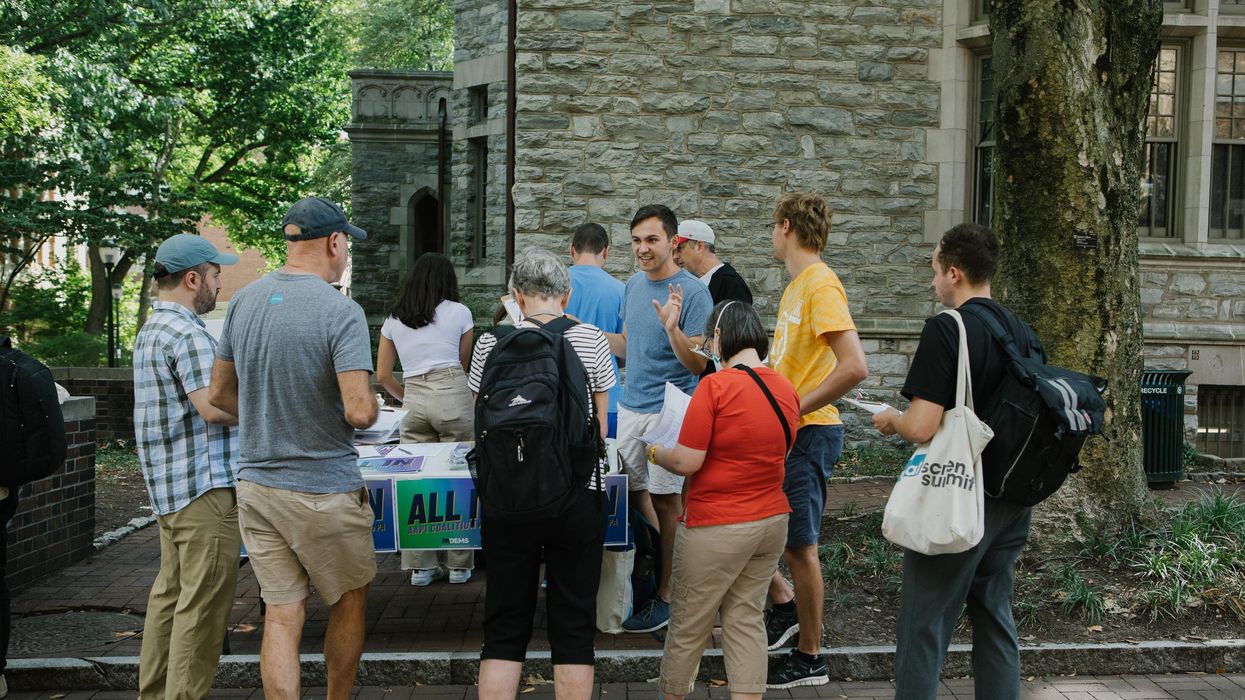Novey is a visiting fellow at the SNF Agora Institute and a consulting community scholar at the University of Maryland’s Center for Democracy and Civic Engagement. Hanmer is a professor of politics at the University of Maryland and research director for the Center for Democracy and Civic Engagement.
\u201cISU has earned the Highly Established Action Plan Seal for the 2022 election for its action plan, spearheaded by our own Dr. @KarenKedrowski. \n\nWe are one of 82 campuses to be so recognized by the ALL IN Campus Democracy Challenge.\u201d— Iowa State Dept of Political Science (@Iowa State Dept of Political Science) 1661780700
Tweets like above from Iowa State are a sign of how the movement for 100 percent student voting has built a culture around action planning that has permeated campus communities across the country. What is action planning, and how does it work?
As defined in the Strengthening American Democracy Guide, “an action plan is a roadmap that documents specific strategies for starting new programs and initiatives, or improving existing ones.” In other words, it’s a documented plan that allows student vote leaders to define strategies and then measure results against their objectives.
If you spend much time around the movement for 100 percent student voting, you’ll notice that we care a lot about action plans. Nearly 1,500 campus voting action plans have been developed since 2016. More than 900 campuses enrolling nearly 10 million students have committed to making one in 2022. Coalition partners have come together to vigorously debate and make a shared action planning guide and simulations based on that guide, as well as rubrics to assess action plans and awards for the best action plans and so much more. Even policymakers are enthusiastic: Maryland and California now require most colleges to develop voting action plans, and campus action planning provisions were included in the voting rights bill that passed the U.S House earlier this year.
The movement for 100 percent student voting focuses intensely on action plans because they have proven to be an enormously useful tool for building power. The action planning process provides needed structure for local leaders who are committed to 100 percent student voting but need guidance about how to pursue these goals. Action planning makes it much easier for nonprofit partners to work together to support local leaders. Action planning enables philanthropic partners to invest in existing local efforts rather than spending more to impose something lower quality from outside the community. The expert “ground truth” consensus of practitioners and community partners in the movement is that action planning works.
A new literature review from our colleague Amy Meli at the Center for Democracy and Civic Engagement at University of Maryland synthesizes insights from across the academic literature to deepen and inform this community consensus about action planning. She looks at studies from a variety of disciplines including industrial and organizational psychology, social work and public health to answer a critical question facing the movement for 100 percent student voting. What can the academic literature tell us about when and how action planning for campus voting works?
Scenario planning is good
Meli highlights a range of literature that shows that “if-then” planning, where participants pre-determine a response to a specific stimuli, is particularly effective. This is an important insight as campus voting plans often require local leaders to navigate uncertainty about the political, legal and public health contexts in which students will be voting. Research suggests that movement tools like Votes & Ballots that allow campuses to immerse themselves in potential future scenarios and think through what they would do should be particularly effective.
Self-efficacy matters
Organizers in the movement for 100 percent student voting have grappled for years to manage the tension between inspiring local leaders to be more ambitious and demoralizing them with unachievable dreams. Strategies to manage these tensions are baked into the design recognition programs like the Voter Friendly Campus Designation and the ALL IN Campus Democracy Challenge. These programs recognize incremental progress, don’t shame low performers as “losers” of a competition and create “ladders of recognition” that enable local leaders to set a goal of reaching the next achievable “rung.” Meli reviews a range of academic literature that validates this overall approach.
Group and institutional planning can be a double edged sword
Meli’s review does contain several elements that should be cause for some concern, reflection and adjustment in the movement for 100 percent student voting. As mentioned above, movement organizers have hyperfocused on institution and group action planning processes as a fundamental movement building block. This focus has permeated local campus cultures, nonprofit programming plans, funding metrics and even public policy.
But the academic literature suggests that action planning in group and institutional settings does not always lead to progress towards our 100 percent student voting movement goals. While action planning can be an effective way to build consensus around shared goals across an institution, they can also be used by institutional leadership to delay action and suppress organic leadership emerging around an issue in different parts of the institution. This is particularly true when action planning is not paired with sufficient evaluation and accountability mechanisms.
The movement for 100 percent student voting has such evaluation and accountability mechanisms built into the current planning rubric such as the use of National Study of Learning, Voting and Engagement reports to determine which campuses get certain kinds of recognition and the withholding of the Voter Friendly Campus Designation from campuses that don’t submit a post-election report of activities.
Meli’s literature review suggests that the movement should double down on these evaluation and accountability efforts. It can feel counterintuitive to spend substantial resources on evaluation and accountability work that occurs after Election Day. But the academic literature suggests that all the action planning that happens in communities before Election Day will be much more effective if movement organizers provide a supportive structure for evaluation and accountability afterwards. It just takes a little bit of discipline and focus from coalition leaders and philanthropic partners to sustain the focus on the action planning process after Election Day.
The upshot? Use action planning thoughtfully!
Meli’s review of the action planning literature makes important contributions to the movement for 100 percent student voting. It validates core assumptions and anecdotal evidence about the power of “if-then” planning tools and goal setting that strengthens self-efficacy. But it also challenges movement leaders to focus more intensely on evaluation and accountability to ensure that the planning process does not inadvertently impede progress and stifle other efforts.
These concerns take on greater significance as policy makers have begun including action planning requirements for campus voting programs in various pieces of state and national legislation. By using action planning thoughtfully and incorporating insights from academic literature the movement for 100 percent student voting can continue to reap the benefits of action planning while mitigating some of the risks that come with using group and institutional planning as a foundational building block for the movement.
This article is a part of the State of the Student Vote Newsletter, a collection of the latest insights and commentary from leading researchers and practitioners in the nationwide movement to grow the #StudentVote.


















